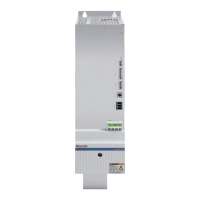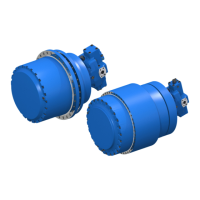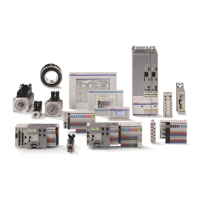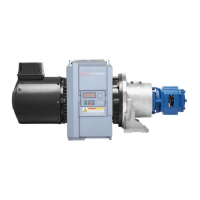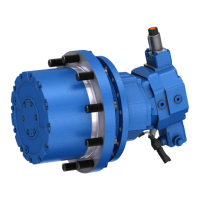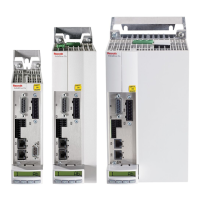Do you have a question about the Bosch Rexroth EFC 3600 and is the answer not in the manual?
General safety guidelines and device handling instructions.
Specifies the required skills and training for personnel working with the device.
Outlines manufacturer's liability regarding product misuse and damage.
Defines safety symbols and their associated hazard levels for clear communication.
Details potential dangers arising from incorrect operation and handling of the device.
Provides specific instructions for mitigating particular risks associated with the device.
Explains measures to prevent electric shock using protective extra-low voltage systems.
Outlines precautions to prevent injury from unintended machine movements.
Addresses safety concerns related to magnetic and electromagnetic field exposure during use.
Warns about hot surfaces and provides instructions for safe handling to prevent burns.
Details safety precautions for handling and mounting the device to prevent injuries.
Describes the intended and correct application of the frequency converter and manufacturer's liability.
Defines situations considered inappropriate use, including operating outside specified conditions.
Instructions for verifying the product model against ordered specifications upon receipt.
Lists the standard components and optional accessories included with the frequency converter.
Specifies ambient and operating conditions for safe transport of the components.
Provides guidelines for storing components to prevent damage, especially concerning capacitors.
Illustrates the physical dimensions of the EFC 3600 for mounting purposes.
Provides a detailed table of dimensions for different EFC 3600 models.
Guides on correct mounting practices, emphasizing ventilation and clearances.
Presents schematic diagrams illustrating the electrical connections for 1-phase and 3-phase models.
Offers crucial notes and precautions for wiring the main circuit of the frequency converter.
Illustrates the main circuit wiring diagram for both 1-phase and 3-phase connections.
Shows the layout of main circuit terminals for different voltage classes.
Provides a detailed description of each main circuit terminal and its function.
Details selection standards for cable and fuse dimensions based on relevant regulations.
Provides step-by-step instructions for connecting the main circuit wiring.
Offers important notes and recommendations for wiring the control circuit correctly.
Illustrates the control circuit terminals and their layout.
Describes the function and signal requirements for each control circuit terminal.
Explains the NPN/PNP switch setting for digital inputs and its default configuration.
Illustrates the electrical diagrams for NPN and PNP operating modes.
Shows the configuration and wiring for analog input terminals.
Provides recommendations for selecting appropriate cables for control circuit wiring.
Offers step-by-step instructions for correctly wiring the control circuit.
Introduces the operating panel, detailing its components and functionality.
Describes the seven-segment display, its capabilities, and how to view different digit sets.
Explains the meaning and function of the various LED indicators on the operating panel.
Outlines the menu structure and navigation within the operating panel for parameter settings.
Provides an illustrative example of how to operate the panel and set parameters.
Lists essential checks and preparations required before powering on and commissioning the device.
Details the step-by-step process for commissioning the frequency converter and motor.
Provides a table of basic parameters for quick setup and rapid operation of the converter.
Explains how to reset parameters to factory defaults and the implications of this action.
Offers troubleshooting guidance for common faults encountered during the commissioning phase.
Covers system parameters including user password, manufacturer password, and access authority settings.
Details basic parameters for frequency setting, run commands, and saving digital frequency settings.
Explains different V/F control modes, including linear, square, and user-defined curves.
Covers parameters related to motor characteristics and encoder configuration for optimal performance.
Details parameters for running the converter, including jogging functions, skip frequencies, and restart settings.
Describes configuration options for digital and analog input terminals, including multi-speed and PLC control.
Explains the configuration of output terminals for various signals like ready, running, and fault indications.
Covers parameters for multi-speed control and simple PLC operation, including acceleration/deceleration times.
Details PID control parameters, including reference/feedback channels and tuning coefficients.
Outlines various protection settings, error codes, and fault handling mechanisms.
Covers communication parameters for ModBus, including protocol settings, baud rate, and data format.
Lists diagnostic messages displayed upon device startup and their possible causes.
Explains how parameter groups are accessed and provides information on parameter backup and password protection.
Details diagnostic messages related to power supply fluctuations and their behavior in stop/run states.
Lists warning messages and their explanations, noting that warnings do not cause automatic shutdown.
Provides a comprehensive list of error codes, possible reasons, and solutions for troubleshooting.
Presents general technical specifications including input/output data, main functions, and protection features.
Lists detailed electrical parameters for different models and power classes of the EFC 3600.
Explains derating conditions related to ambient temperature and mains voltage.
Outlines the general requirements for electromagnetic compatibility and noise immunity.
Explains the basic structure for noise immunity within the drive system.
Discusses the causes of noise emission and factors affecting its propagation.
Provides rules and guidelines for designing and installing drive systems in compliance with EMC standards.
Covers mains filter, control cabinet grounding, and line routing for EMC compliance.
Discusses general information and division into areas for EMC-optimal installation.
Provides exemplary arrangements for control cabinet mounting based on interference areas.
Details design and installation practices for the interference-free area within a control cabinet.
Guides on arranging components and lines in the interference-susceptible area of a control cabinet.
Addresses design and installation in the strongly interference-susceptible area, focusing on motor power cables.
Explains the importance of proper ground connections for EMC compliance.
Recommends measures for routing signal and control lines to minimize interference.
Details measures for suppressing radio interference from inductive loads and switches.
Provides an introduction to brake resistors and their function in energy regeneration.
Shows dimensional drawings for brake resistors with aluminum housing.
Describes communication interface adapters and cables for connecting to PCs or other control units.
Lists accessories specifically for mounting the operating panel in a control cabinet.
Introduces the RS485 communication port and ModBus protocol for network control.
Details the ModBus protocol, including its master/slave structure and transmission modes.
Provides critical safety instructions for performing maintenance on electrical equipment.
Lists daily inspection items and criteria to ensure the longevity of the frequency converters.
Outlines the necessary periodic inspections and their solutions for maintaining the converter's performance.
Provides step-by-step instructions for removing and mounting the operating panel.
Details the procedure for removing and mounting the fan for maintenance or replacement.
Lists essential information to have ready for efficient support inquiries.
Provides guidance on the proper disposal of packaging materials and product components.
Discusses environmental considerations, materials, and recycling of electronic devices.
Lists abbreviations used throughout the manual for clarity and reference.
Contains a comprehensive list of parameters, their attributes, and descriptions for system configuration.
Explains the type coding system for the EFC 3600, its function modules, and accessories.




